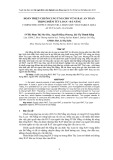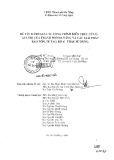
- 231 -
Journal of Heat Island Institute International Vol.7-2 (2012)
Academic Article
Hot Weather Comparative Heat Balances
in Pervious Concrete and Impervious Concrete Pavement Systems
John T. Kevern*1, Liv Haselbach*2, Vernon R. Schaefer*3
*1University of Missouri-Kansas City, Kansas City, MO, USA
*2Washington State University, Pullman, WA, USA
*3Iowa State University, Ames, IA, USA
Corresponding author email: kevernj@umkc.edu
ABSTRACT
Many pavements contribute to the urban heat island (UHI) effect due to their bulk mass and heat absorption capacities.
Granular ground surfaces composed of soils or sands do not contribute to the UHI effect in a similar manner. Their porous nature
may lessen the effect, both with an increased insulating capacity and with an enhanced mechanism for evaporative cooling from
absorbed water.
Pervious concrete is a novel pavement that is being developed to aid in preventing stormwater-related environmental
problems. Pervious concrete has a network of interconnected voids, which allow water exfiltration to the subbase below. Limited
studies indicate that a pervious concrete surface can have more elevated temperatures than those of similar traditional impervious
pavements, but also that temperatures are lower under the pavements.
This study focuses on a site in Iowa where both a pervious concrete and a traditional concrete paving system have been
installed and where temperatures were recorded within the systems for extended time periods. The analyses cover days with
negligible antecedent precipitation and high air temperatures, which are extreme conditions for UHI impact. This paper compares the
increase in overall heat stored during several diurnal heating cycles in both of these systems. These analyses include not only the
temperatures at various depths, but also the heat stored based on the bulk mass of the various layers in each system and below grade.
Results suggest that pervious concrete pavement systems store less energy than do traditional systems and can help mitigate UHIs.
(245 words)
Introduction
The urban heat island (UHI) effect has been studied
in many cities, and the contribution of daytime heating to UHIs
is well established (Eliasson 1996; Asaeda et al. 1996;
Pomerantz 2000). Many traditional pavement types are known
to be contributors to the UHI effect due to their bulk mass and
heat absorption capacities. Previous research has shown that
higher albedo surfaces and shading can offset some of the
impact by reducing the solar energy absorbed in the pavements
(Akbari 2001). Lighter colors and higher albedos tend to aid in
the mitigation of the UHI by limiting solar energy absorbed
into the system. The solar reflectance index (SRI) is being used
as a variable to compare the coolness of various traditional
pavements and has been accepted by the US Green Building
Council (USGBC) in its Leadership in Energy and
Environmental Design (LEED™) Green Building rating system
as a methodology for determining if a pavement design aids in
mitigating the UHI effect (Haselbach 2008; Marceau and Van
Geem 2007). This variable is used independently of any other
pavement parameter, with the assumption that the pavements
compared have similar heat absorption and transfer
characteristics below the surface, although some studies
acknowledge that subsurface characteristics may be important
(Gui et al. 2007).
Natural and manmade granular ground surfaces
composed of soils or sands are not considered to be
contributors to the UHI effect due to their porous nature. Of
interest herein is the impact of the porosity of a pavement
system on its capacity to absorb and store energy. It has been
suggested that the voids within highly pervious pavements may
insulate the ground, mitigating UHI impact (Haselbach and
Gaither 2008). Permeable surfaces may also allow for
evaporation of water that infiltrates into the media, aiding in
cooling through evaporation.
A group of novel pavements, referred to as permeable
pavements, are being developed to aid in preventing
stormwater-related environmental problems. Permeable
pavements allow stormwater to infiltrate into the ground,
reducing runoff and avoiding costly additional stormwater
control devices to manage flooding and pollution dissemination
downstream. One such pavement is Portland Cement Pervious
Concrete (PCPC), which provides a hardscape similar to those
of traditional impermeable concrete or asphalt pavements, but
also consists of a network of interconnected macro-pores that
readily allow water exfiltration to the subbase and provide
some water storage for further evaporation or infiltration. A
question of interest is how pervious concrete might perform
due to its unique pore structure, as compared with the
performance of traditional concrete under very hot conditions
typical for the UHI.

- 232 -
Asaeda and Ca (2000) studied several surface media
during two days of extreme heat in 1994. Their results indicate
that certain types of permeable pavements, particularly blocks,
did not necessarily aid in abetting the UHI effect. Detailed
information was not given for all the media used, and therefore
a clear picture of how many of the porous pavements might
react did not emerge. Only a few studies have been published
about the temperature impact of using PCPC instead of other
impervious pavement surfaces. From these, it is apparent that
the PCPC surface can have more elevated temperatures than do
traditional impervious pavements, but also that temperatures
decrease rapidly under the pavement (Haselbach and Gaither
2008; Kevern et al. 2009a). None of the published studies
compared PCPC and traditional pavements with respect to their
overall energy balances in periods of extreme heat.
This study focuses on a site located at Iowa State
University (ISU), where both a pervious concrete and a
traditional Portland Cement Concrete (PCC) paving system
were installed and temperature readings were taken within the
systems for extended time periods. The site was constructed as
part of the Iowa Pervious Concrete Stormwater project and also
contained monitors and collectors to quantify stormwater
improvements observed from the pervious concrete. The
analysis covers days with typical high air temperatures greater
than 32° C (90° F), with negligible antecedent precipitation
(i.e.,, no rain events in the previous 7 days), which are extreme
conditions for UHI impact.
The pervious concrete is seen to have higher
mid-pavement temperatures at midday than does traditional
concrete, but both locations have similar temperatures during
the night/early morning. However, in order to study UHI
effects, the fluctuations in heat storage over both the complete
systems should be evaluated with steady background soil
temperatures below the pavement systems. The analysis in this
paper compares the overall heat stored during several diurnal
cycles in the summer for both of these systems. The analysis
includes not only the temperatures at various depths, but also
the heat stored, based on the bulk mass of the various layers in
each system.
Although many of the pervious systems studied had
higher surface temperature readings than did traditional
concrete systems, the latter appear to have significantly higher
below-grade insulating capabilities. This may make it possible
to design pervious concrete systems to mediate or reverse
additional UHI impact more effectively than through traditional
pavement surfaces.
Site Description
ISU parking lot 122 was constructed as the
Department of Natural Resources Iowa Pervious Concrete
Water Quality Project, with the objective to quantify the
environmental impact of pervious concrete parking areas. The
site was designed to monitor both the quantity and quality of
stormwater effluent from equally sized traditional and pervious
concrete parking areas. Temperature and soil moisture sensor
arrays were installed in both of the pavement profiles to
monitor frost-line penetration and infiltration characteristics.
Water-level sensors in the pervious concrete aggregate bases
coupled with monitoring wells allowed estimation of
infiltration rates and the impact on local groundwater
conditions. The site was constructed during the summer and
fall of 2006 and opened to traffic on December 4, 2006.
Sensors were installed to compare the stormwater
characteristics and thermal behavior of the two areas. Flow
meters and automated samplers were installed to measure and
collect stormwater from the PCC surface and from the PCPC
base. Water-level sensors in the aggregate bases and
monitoring wells were installed to determine actual infiltration
and compare with theoretical values. Volumetric soil moisture
arrays were installed under each pavement to determine
infiltration characteristics. Temperature sensor arrays
(Campbell Scientific T107L) were installed into and
underneath both pavements to monitor thermal behavior.
Surface sensors were omitted due to concerns about winter
plowing operations. The location and assigned names of the
temperature sensor profiles are shown in Figure 1 for both the
PCPC and PCC pavements. Table 1 provides a description of
the sensors, along with the depth below the pavement surface.
45 cm 15cm
Pervious Concrete (PCPC) Traditional Concrete (PCC)
Mid-PCPC
Mid-Agg Base
Mid-PCC
Soil Interface
15 cm in soil
45 cm in soil
T
pcpc, 8 cm
Bottom of Agg. Base
T
pcpc, 40 cm
T
pcpc, 60 cm
T
pcc, 8 cm
T
pcc, 15 cm
T
pcc, 30cm
T
pcc, 60cm
Figure 1. Pavement cross section and sensor placement

- 233 -
Table 1. Sensor descriptions
Methodology
As the sun’s energy is absorbed by the pavement, it
warms. Later, the cooling cycle begins, and the pavement
radiates heat when the temperature of the pavement surface
becomes greater than the temperature of the atmosphere above
(i.e., the sun sets). The increased energy required for air
conditioning caused by the UHI effect is directly related to the
amount of energy absorbed and then released by the pavement
system. A reduction in the total energy stored in a pavement
system will help mitigate this effect. To accurately compare the
energy stored in two systems, all energy storage calculations
must be performed to a depth where the temperatures are equal.
For the two pavements discussed herein, at a depth of 60 cm
below the pavement surfaces, the temperature difference was
less than 1° C and assumed equal.
Equation 1 is used to calculate the amount of energy
stored during the heating cycle of the PCC system. The specific
equations include the amount of heat stored in the pavement
and segregated soil layers corresponding to the temperature
sensors. The first term represents the energy stored in the
traditional concrete. The average temperature of the PCC was
taken as the temperature recorded at mid-height in the
pavement. The second term represents the energy stored in the
first 15 cm of soil beneath the PCC pavement. The temperature
in the first 15 cm was taken as an average of the sensor located
directly under the pavement and the sensor located 15 cm in the
soil. The third term represents the energy stored in the soil
between 15 cm and 45 cm beneath the PCC pavement. The
temperature in this deeper layer was taken as the average
between the temperature recorded at 15 cm beneath the
pavement and the sensor located at 45 cm beneath the
pavement.
))(
2
)((
))(
2
)(())()((
6030
60,30,
3015
30,15,
8,
cmcm
cmpcccmpcc
VSoil
cmcm
cmpcccmpcc
VSoilpcccmpccVpccpcc
h
TT
C
h
TT
ChTCE
→
→
∆+∆
+
∆+∆
+∆=∆
Equation 2 is used to calculate the amount of energy
stored during the heating cycle of the PCPC system. The
specific equations include the amount of heat stored in the
pavement and segregated aggregate base layers corresponding
to the temperature sensors. The first term represents the energy
stored in the pervious concrete. The average temperature of the
PCPC layer was taken as the temperature recorded at
mid-height in the pavement. The second term represents the
energy stored in the aggregate base beneath the PCC pavement.
The temperature in the aggregate base was taken as the value
recorded at mid-level in the aggregate base.
))()(())()(( .40,.:8, baseaggcmpcpcbaseaggvpcpccmpcpcVpcpcpcpc hTChTCE ∆+∆=∆
(
2)
Where:
ΔEpcc is the amount of energy stored during the
daily heating cycle per unit area from the PCC
pavement surface to 60 cm below the surface,
J/(cm2°C)
ΔEpcpc is the amount of energy stored during the
daily heating cycle per unit area from the PCPC
pavement surface to 60 cm below the surface,
J/(cm2°C)
Cvi is the volumetric heat capacity of layer ‘i’ such
as the PCC or soil layer
ΔTj is the change in temperature during heating
reported by the sensor at location ‘j’
hi is the height of the particular layer ‘i’
(1)
Sensor Description Depth Below Surface (cm)
Tpcpc, 8cm Mid-level in PCPC 8 cm
Tpcpc, 40cm Mid-level in aggregate base 40 cm
Tpcpc, 60cm Bottom of aggregate base 60 cm
Tpcc, 8cm Mid-level in PCC 8 cm
Tpcc, 15cm PCC/Soil interface 15 cm
Tpcc, 30cm 15 cm in soil 30 cm
Tpcc, 60cm 45 cm in soil 60 cm

- 234 -
Traditional Concrete System
The PCC system contained 15 cm of concrete
pavement over a compacted soil subgrade. The volumetric heat
capacity (Cvpcc) of the concrete was taken as 2.1 J/cm3°C
(Asaeda et al. 1996) and a standard density (ρ) was assumed
(Mehta and Monterio 1993). Soil density was tested at 12
locations under the PCC, with an average value of 1.9 g/cm3.
The heat capacity of the soil was determined from the
relationship between concrete heat capacity and density, along
with the soil actual density. A summary of values is shown in
Table 2. The effects of moisture were not considered for this
portion of the study. As previously noted, the data evaluated
were all from time periods with negligible antecedent
precipitation.
Table 2. Material properties
Material
Cv (J/cm3°C) ρ (g/cm3)
PCC 2.1 2.4
Soil 1.7 1.9
PCPC 1.55 1.8
Agg. Base 1.2 1.44
Pervious Concrete System
The pervious concrete system consisted of 15 cm of
pervious concrete over a 45 cm compacted limestone-aggregate
base storage layer. The porosity of the pervious concrete was
measured as 31% (Kevern et al. 2009b). The traditional
concrete was air entrained, and porosity was assumed at 5%.
Therefore, the volumetric heat capacity of the pervious
concrete was taken as a proportion of solids versus the
traditional concrete, as in Equation 3.
CvPCPC = CvPCC (100-n)/100 (3)
Where:
CvPCPC is the adjusted volumetric heat capacity of
the pervious concrete
CvPCC is the selected volumetric heat capacity of the
concrete (2.1 J/cm3°C)
n is the difference in porosity between the PCC
and PCPC (31%–5% = 26%)
The dry density of the limestone base was measured
as 1.44 g/cm3. The specific heat storage capacity of limestone
was taken as 0.84 J/g°C, yielding a volumetric heat capacity of
1.2 J/cm3°C (engineeringtoolbox 2009). A summary of the
material property values used is shown in Table 2.
Results
The typical daily temperatures at the mid-heights of
both pavements and the air are shown in Figure 2. During the
day, the temperature at mid-level in both pavements was
always warmer than the air temperature, with the PCPC
approximately 5° C (9° F) warmer than the PCC pavement
right after the hottest period of the day. Although the PCPC
was warmer during the day, both pavements cooled to similar
temperatures during the night.
0
5
10
15
20
25
30
35
40
45
50
0:00 8:00 16:00 0:00
Temperature (°C)
Time (hrs)
Air Temp
TPCPC, 8cm
Tpcc, 8cm
Figure 2. Typical pavement hot weather temperature behavior (07/07/07)

- 235 -
The temperature behavior of the PCPC system with
depth is shown in Figure 3 for the same time period shown in
Figure 2. The changes in the PCPC temperature followed
closely behind the air temperature variations, and temperatures
fluctuated less with depth. The 60 cm depth fluctuated less than
1° C over the analyzed time period.
The temperature behavior of the impervious PCC
system with depth is shown in Figure 4 for the same time
period as Figure 2 and Figure 3. The changes in PCC
temperature in the upper layer of soil (15 cm below grade) were
warmer than the changes in air temperature, but followed a
similar heating trend. At 30 cm below grade, the temperature
response was buffered, with only a slight daily variation and a
significant phase lag, as compared with the air temperature
heating cycle. Temperature at 60 cm below grade for both
pavement types remained similar and constant.
0
5
10
15
20
25
30
35
40
45
50
0:00 8:00 16:00 0:00
Temperature (°C)
Time (hrs)
Air Temp
Tpcpc, 8cm
Tpcpc, 40cm
Tpcpc, 60cm
Figure 3. Typical temperature behavior of the pervious concrete system (07/07/07)
0
5
10
15
20
25
30
35
40
45
50
0:00 8:00 16:00 0:00
Temperature (°C)
Time (hrs)
Air Temp
Tpcc, 8cm
Tpcc, 15cm
Tpcc, 30cm
Tpcc, 60cm
Figure 4. Typical temperature behavior of the impervious concrete system (07/07/07)

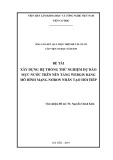
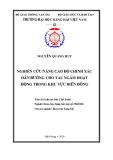
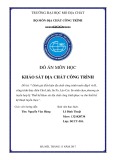
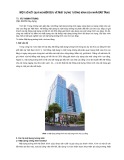
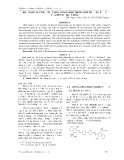

![Thuyết minh tính toán kết cấu đồ án Bê tông cốt thép 1: [Mô tả/Hướng dẫn/Chi tiết]](https://cdn.tailieu.vn/images/document/thumbnail/2016/20160531/quoccuong1992/135x160/1628195322.jpg)

